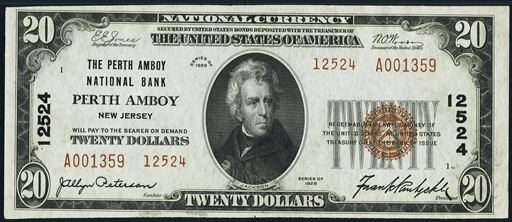The First National Bank Of Wilkes-Barre
The First National Bank Of Wilkes-Barre in Pennsylvania printed $9,967,170 dollars worth of national currency. Once a bank issues that much money there really isn’t much room for rare issues. However, there are certainly exceptions to every rule. This national bank opened in 1863 and stopped printing money in 1882, which equals a 20 year printing period. That is a fairly normal lifespan for a national bank. During its life, The First National Bank Of Wilkes-Barre issued 16 different types and denominations of national currency. We have examples of the types listed below. Your bank note should look similar. Just the bank name will be different. For the record, The First National Bank Of Wilkes-Barre was located in Luzerne County. It was assigned charter number 30.
We buy all national currency. Please call or email us for a quote. Sales@AntiqueMoney.com
The First National Bank Of Wilkes-Barre in Pennsylvania issued 7,100 sheets of $5 original series national bank notes. Just because a print range is between 5,000 and 10,000 doesn’t mean that individual notes will be easy to buy. That number isn’t really high or low. Some notes are extremely rare and some could be from a hoard. Values are determined based on condition and the number of known survivors. Each five dollar original series bank note has a spiked red seal. That is pretty much the only design difference between it and later issues. These are really beautiful notes. One neat thing about these is that the back of each note has a vignette of the corresponding state seal. Some of the state seals are very imaginative. Collecting by state seal was very popular early on in the hobby. Today most collectors are more concerned about bank of issue and condition. Serial number one bank notes are also extremely popular.
Original Series $5 National Bank Note
The First National Bank Of Wilkes-Barre printed 5,500 sheets of $10 original series national bank notes. Just because a print range is between 5,000 and 10,000 doesn’t mean that individual notes will be easy to buy. That number isn’t really high or low. Some notes are extremely rare and some could be from a hoard. Values are determined based on condition and the number of known survivors. These notes were issued during the glory days of the national bank note era. Each $10 bill was pen signed by the president and cashier of the bank. Small towns and large cities both issued these notes. Of course the small town issuers tend to be scarcer today. Prices range from $500 to thousands of dollars (and more if the condition and rarity warrant it). Contact us if you need help valuing your bank note.
Original Series $10 National Bank Note
The First National Bank Of Wilkes-Barre also printed 5,500 sheets of $20 original series national bank notes. That issue number may or may not sound like a lot of sheets depending on your experience with collectible currency. However, all original series $20 bills are rare. The production amount is irrelevant when it comes to values. These seem like common issues until you want to buy one. These just aren’t readily available from rare banks in very fine or better condition. We definitely feel like these are undervalued in today’s market.
Original Series $20 National Bank Note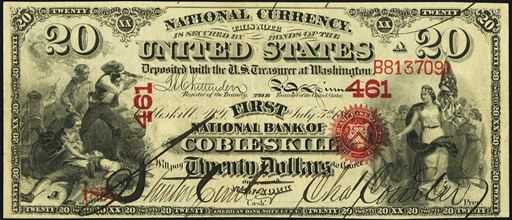
The First National Bank Of Wilkes-Barre also printed 1,460 sheets of $50 original series national bank notes. The printing number for original series $50 bills is irrelevant. There are only about 35 known to exist from all banks in the country. Despite being extremely rare, condition is still very important. Lots of first charter fifty dollar bills are heavily circulated; there are significant premiums for anything that grades extremely fine or higher.
Original Series $50 National Bank Note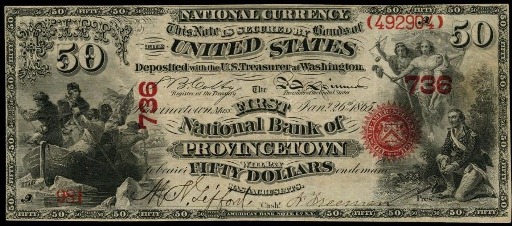
The First National Bank Of Wilkes-Barre also printed 1,460 sheets of $100 original series national bank notes. The same piece of advice applies here as it does to first charter fifties. These are rare enough to the point that printing numbers don’t matter. The same condition guidelines apply to original series $100 bank notes. These traded hands frequently and are often found in “well-used” states today. As with other bank notes, there can be huge price gaps between different grade points.
Original Series $100 National Bank Note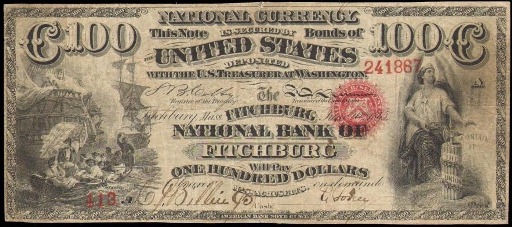
The First National Bank Of Wilkes-Barre also printed 3,930 sheets of $5 series of 1875 national bank notes. Hundreds of banks had sheet outputs between 2,500 and 5,000. That is pretty typical for a medium sized national bank in the 1870s. Series of 1875 $5 bills are some of the most commonly encountered bank notes from the first charter series. Only the original series $1 bill is more available. Some banks exclusively issued five dollar bills. So if you want an example from one of those banks then you don’t have many options. These notes have a rounded red seal and red serial numbers. They also all have a red charter number.
Series of 1875 $5 National Bank Note
The First National Bank Of Wilkes-Barre also printed 4,018 sheets of $10 series of 1875 national bank notes. Hundreds of banks had sheet outputs between 2,500 and 5,000. That is pretty typical for a medium sized national bank in the 1870s. The two vignettes seen on 1875 $10 bank notes are “Franklin and Electricity” and “America Seizing Lightning”. These notes occasionally confuse novices because the year 1752 is printed on them. That is when Benjamin Franklin discovered electricity. It has nothing to do with when these bank notes were issued. The back of each $10 bill has “DeSoto Discovering the Mississippi.”
Series of 1875 $10 National Bank Note
The First National Bank Of Wilkes-Barre also printed 4,018 sheets of $20 series of 1875 national bank notes. The exact number of series of 1875 $20 national bank notes printed by this bank is good to know. Don’t expect a high number to lower the value or a small number to increase the value. These notes are scarce enough on their own that the stats don’t really matter. Twenty dollars was a lot of money between 1875 and 1901, which is the time period in which these were printed. These just weren’t saved in high numbers.
Series of 1875 $20 National Bank Note
The First National Bank Of Wilkes-Barre also printed 400 sheets of $50 series of 1875 national bank notes. The printing number for original series $50 bills is irrelevant. There are only about 35 known to exist from all banks in the country. To make matters worse, these are not being discovered much at all these days. The supply is pretty constant, as is the demand. Prices start at about $10,000 and can go up sharply from there.
Series of 1875 $50 National Bank Note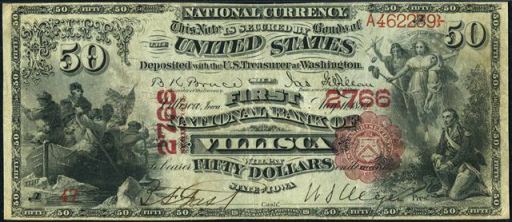
The First National Bank Of Wilkes-Barre also printed 400 sheets of $100 series of 1875 national bank notes. There are currently only about 70 series of 1875 $100 national bank notes known to exist. So the sheet output is really only included for factual purposes – it won’t affect values. The actual value is based on condition and bank of issue. If you don’t know how to grade currency, then send us pictures of what you have. We can help you grade and value any national bank note. Of course series of 1875 $100 bank notes would be a treat to see.
Series of 1875 $100 National Bank Note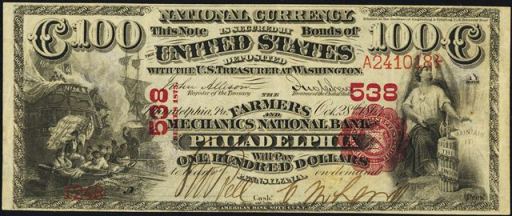
The First National Bank Of Wilkes-Barre also printed 120,868 sheets of $10 1902 blue seal national bank notes. Sadly, a printing range that high means that these blue seal bank notes from this bank are not going to be extremely rare. 1902 $10 blue seal bank notes all have a portrait of William McKinley on them. Values can range from as little as $40 up to over $10,000. There really is no trick to know what is rare and what is common by just doing an internet search. You really need to work with an expert (like us) in order to determine the value of your specific bank note. There are at least ten different factors than can make some 1902 $10 blue seals worth more than others. We know exactly what to look for and we would be happy to provide a free appraisal and our best offer.
1902 $10 Blue Seal National Bank Note
The First National Bank Of Wilkes-Barre also printed 120,868 sheets of $20 1902 blue seal national bank notes. The same rarity rules for 1902 $10 blue seals also apply to $20 blue seals. Just remember that $20 bills are by nature three times rarer (unfortunately they don’t command a premium over other denominations). Hugh McCulloch is pictured on the front of each bill. Contact us if you need pricing help.
1902 $20 Blue Seal National Bank Note
The First National Bank Of Wilkes-Barre also printed 26,310 sheets of Type1 1929 $10 national bank notes. Sadly, based on a number that high, there is basically no chance for these notes to be especially rare. Each $10 bill from 1929 has a portrait of Alexander Hamilton on it. The black number written vertically is the charter number. The charter number never affects the value; it is just an identifier. The ten dollar type1 national bank note happens to be the single most common national bank note, with over 65,000 known to exist from all banks. Of course each note is valued based on its condition and rarity. Some are very rare.
Series of 1929 Type1 $10 National Bank Note
The First National Bank Of Wilkes-Barre also printed 7,104 sheets of Type1 1929 $20 national bank notes. Sadly, based on a number that high, there is basically no chance for these notes to be especially rare. Andrew Jackson is featured on the front of each 1929 $20 bill. Be sure to take note of the serial number on your specific bank note. If it is 000001 then you can expect a nice premium. There is a special market for serial number one bank notes. Of course, even if the number isn’t #1, it could still be collectible and have a high value just based on its condition and rarity alone.
Series of 1929 Type1 $20 National Bank Note
The First National Bank Of Wilkes-Barre also printed 33,595 individual notes from the type2 1929 $10 national bank note series. That is a high printing total. Don’t expect much rarity here, but condition factors can always make common items more valuable. The easiest way to spot the difference between type1 1929 $10 bills and 1929 type2 $10 bills is in the serial number. Type2 notes have a serial number that ends with a number. 1929 type1 notes have a serial number that ends with the letter A. Generally speaking, these $10 bills are rarer than the earlier type1 issues. However, most collectors don’t pay more for that rarity because they look basically the same.
Series of 1929 Type2 $10 National Bank Note
The First National Bank Of Wilkes-Barre also printed 9,062 individual notes from the type2 1929 $20 national bank note series. This is a pretty typical print run for type2 national bank notes. Values will be across the board based on demand. One of the great things about 1929 type2 $20 national bank notes is that they really aren’t that old and some can be extremely rare. Until the big head $20 series started there really wasn’t much difference between something printed in 1929 and the same bill printed in 1993. We have bought some examples in the past few months that people just found in their change.
Series of 1929 Type2 $20 National Bank Note